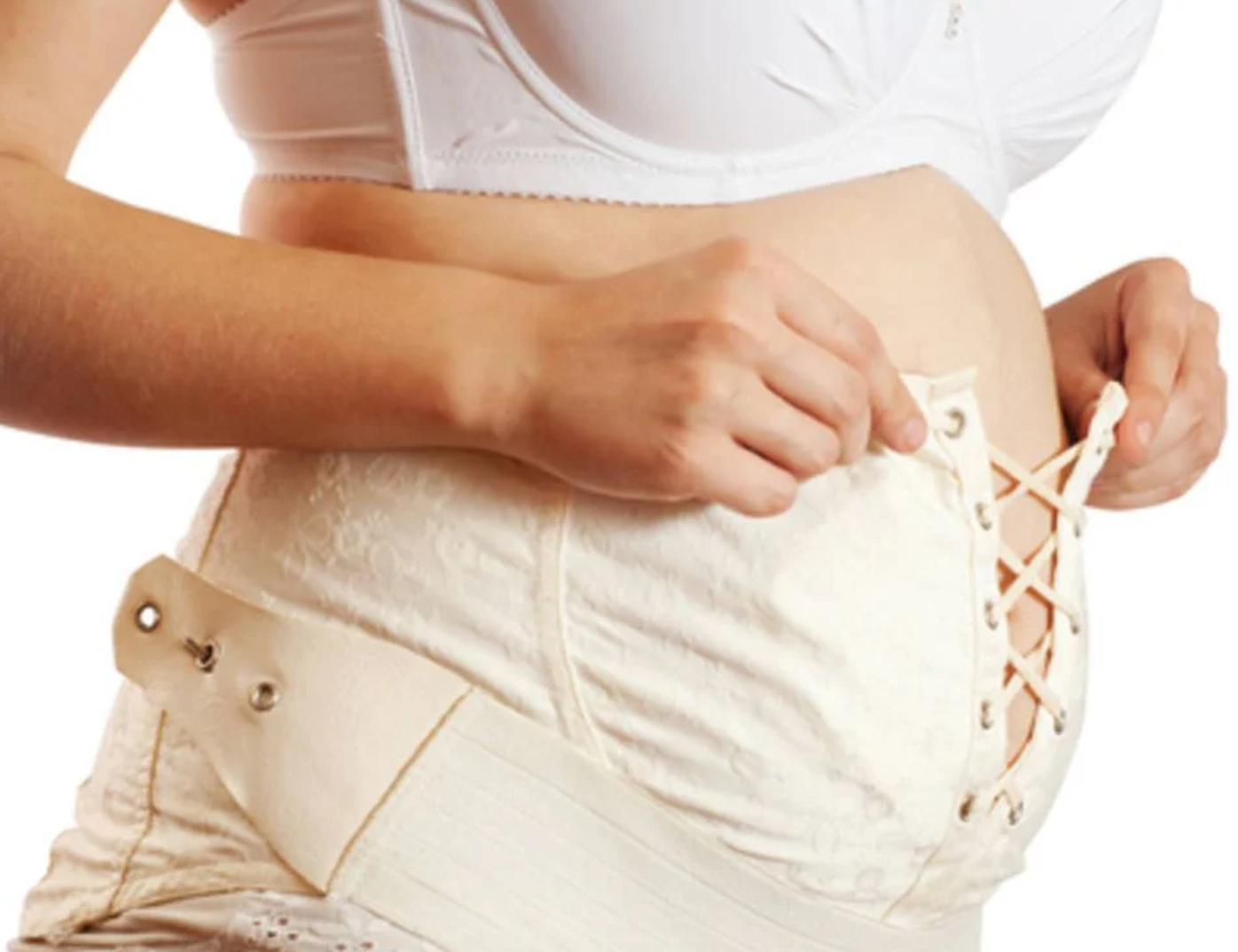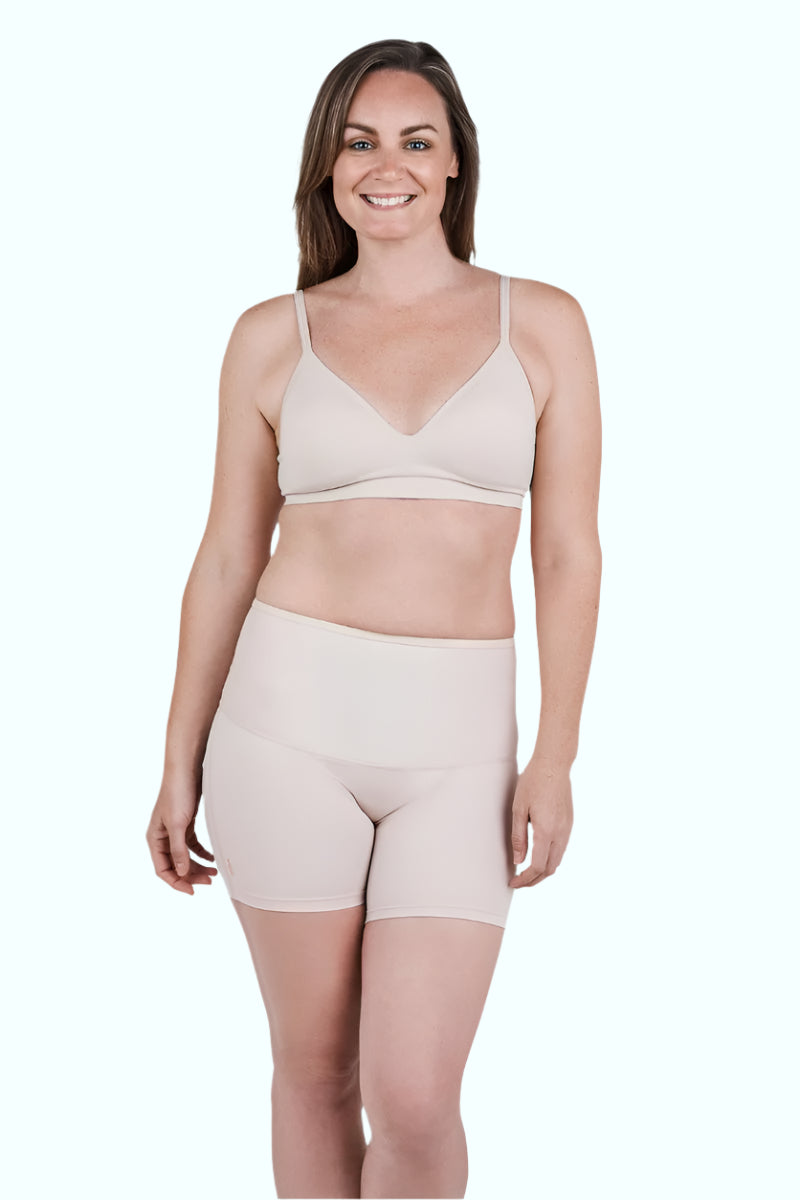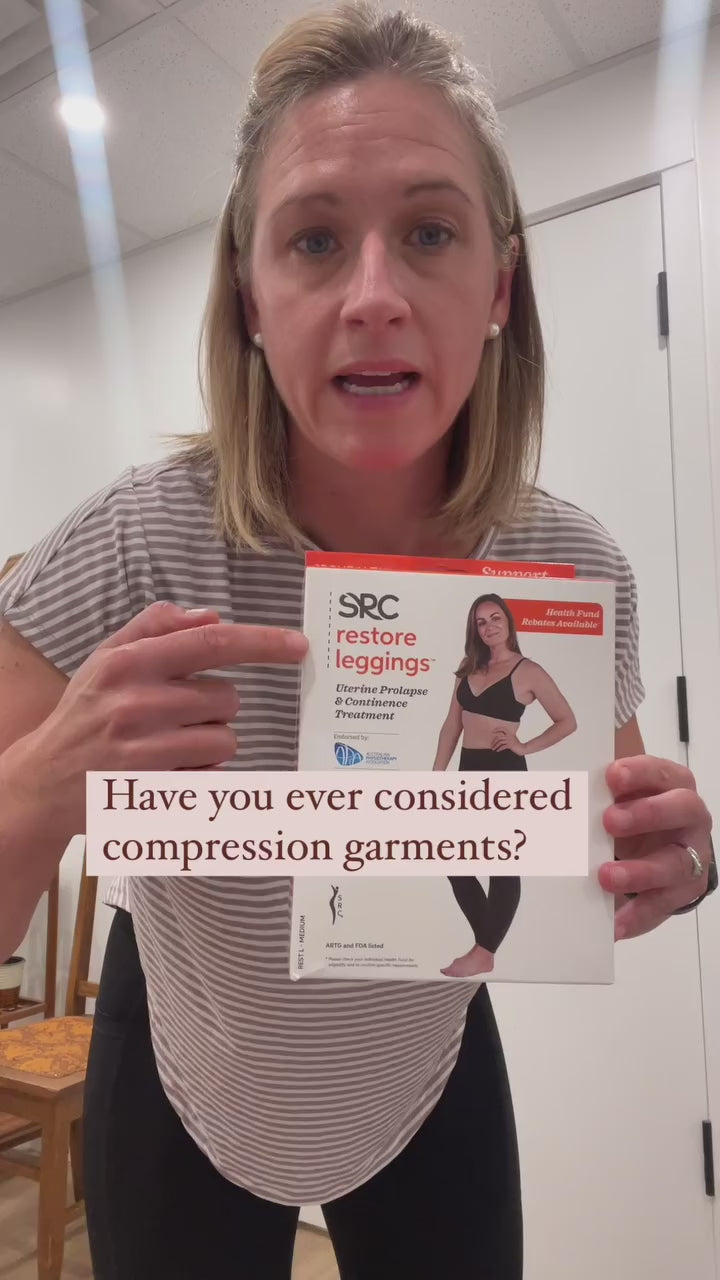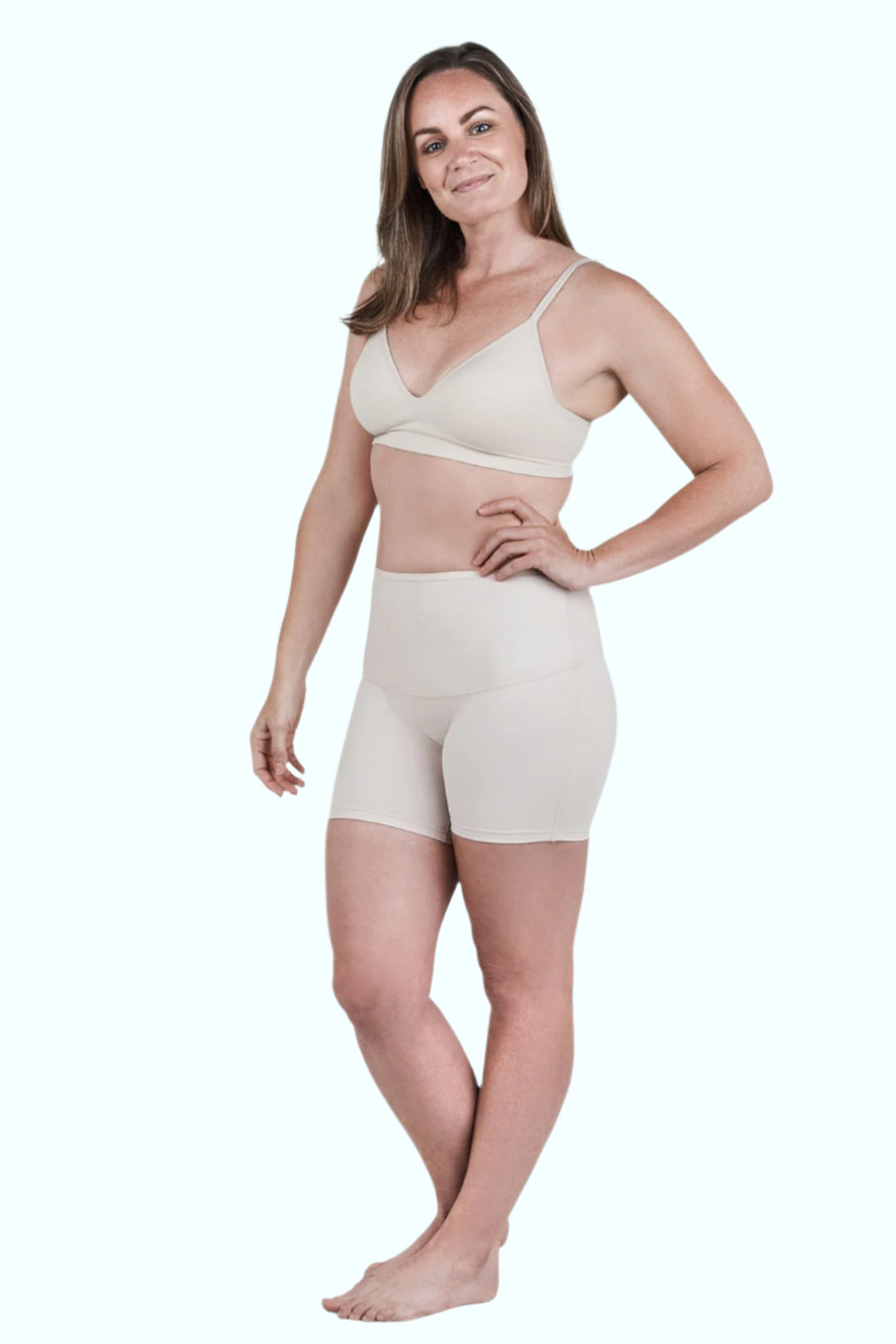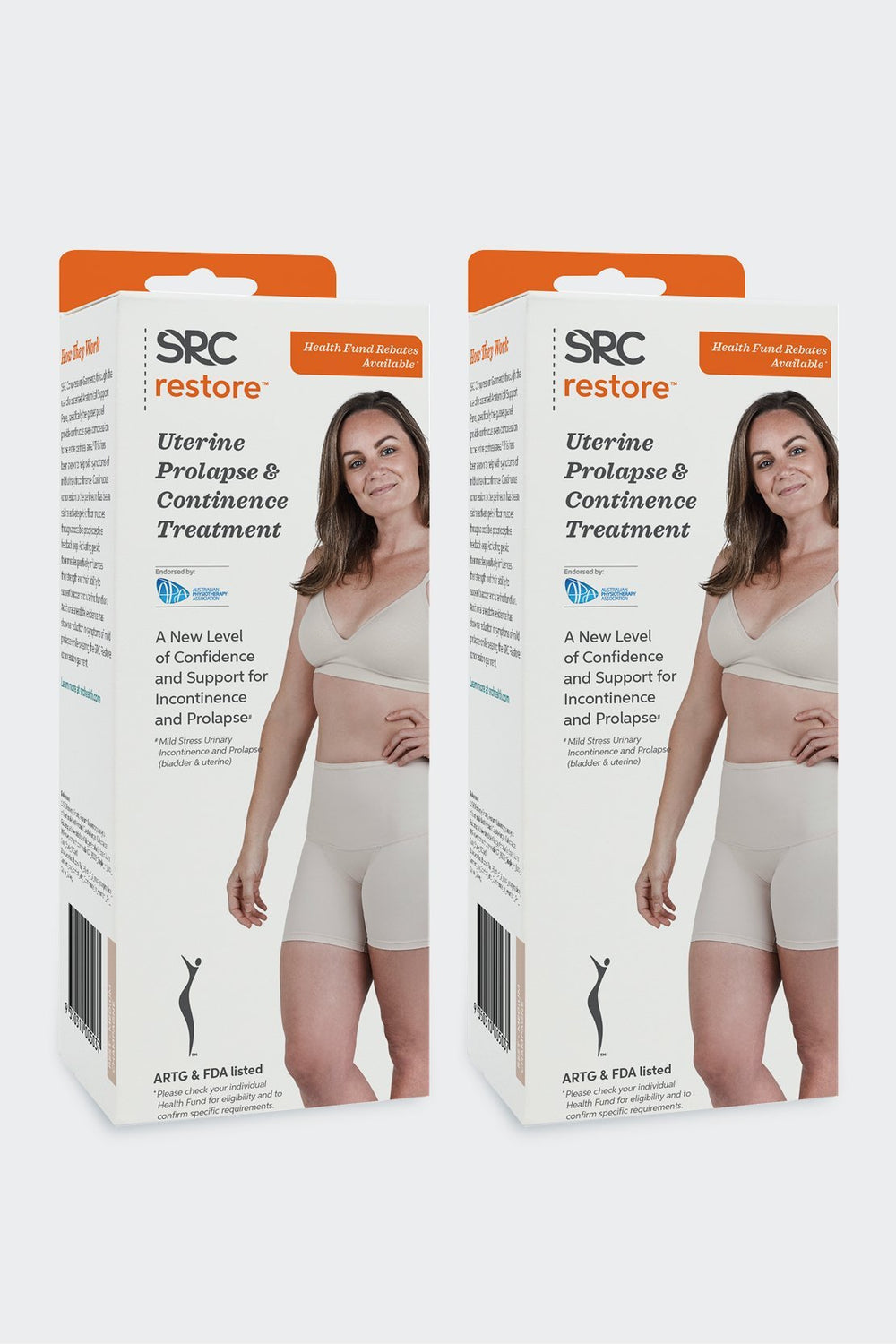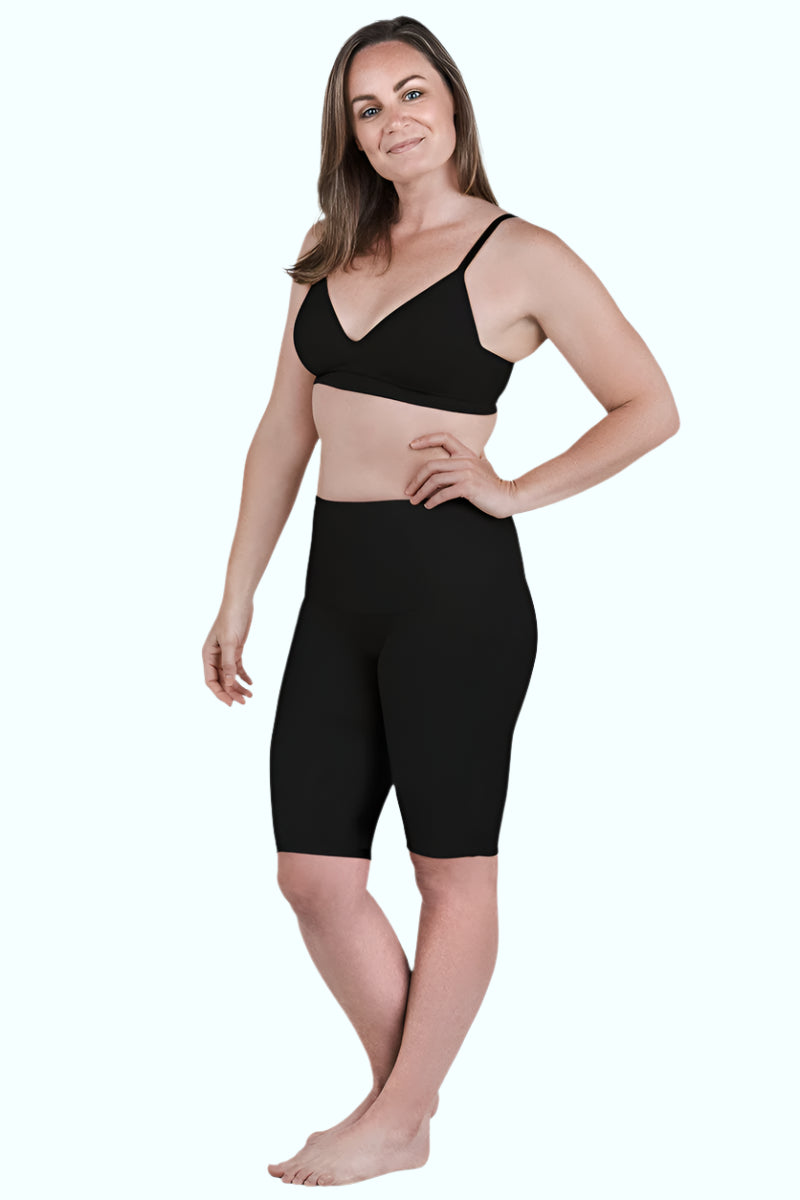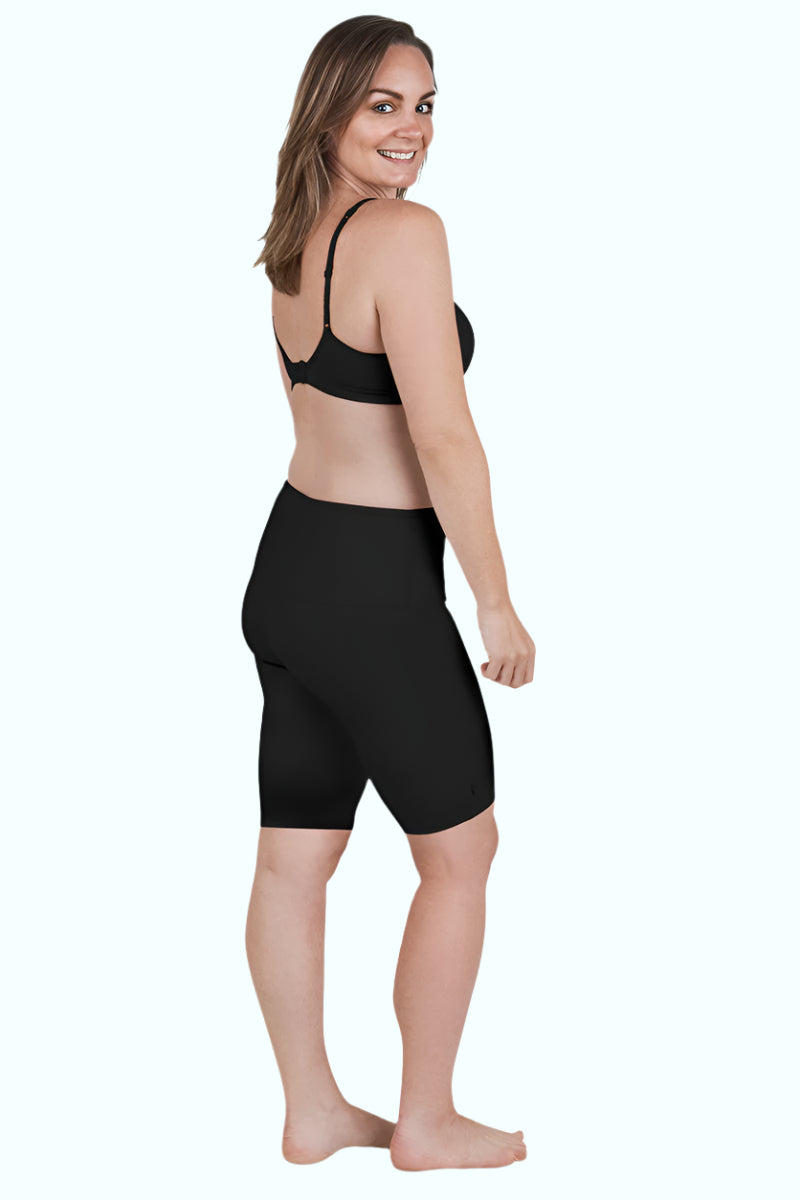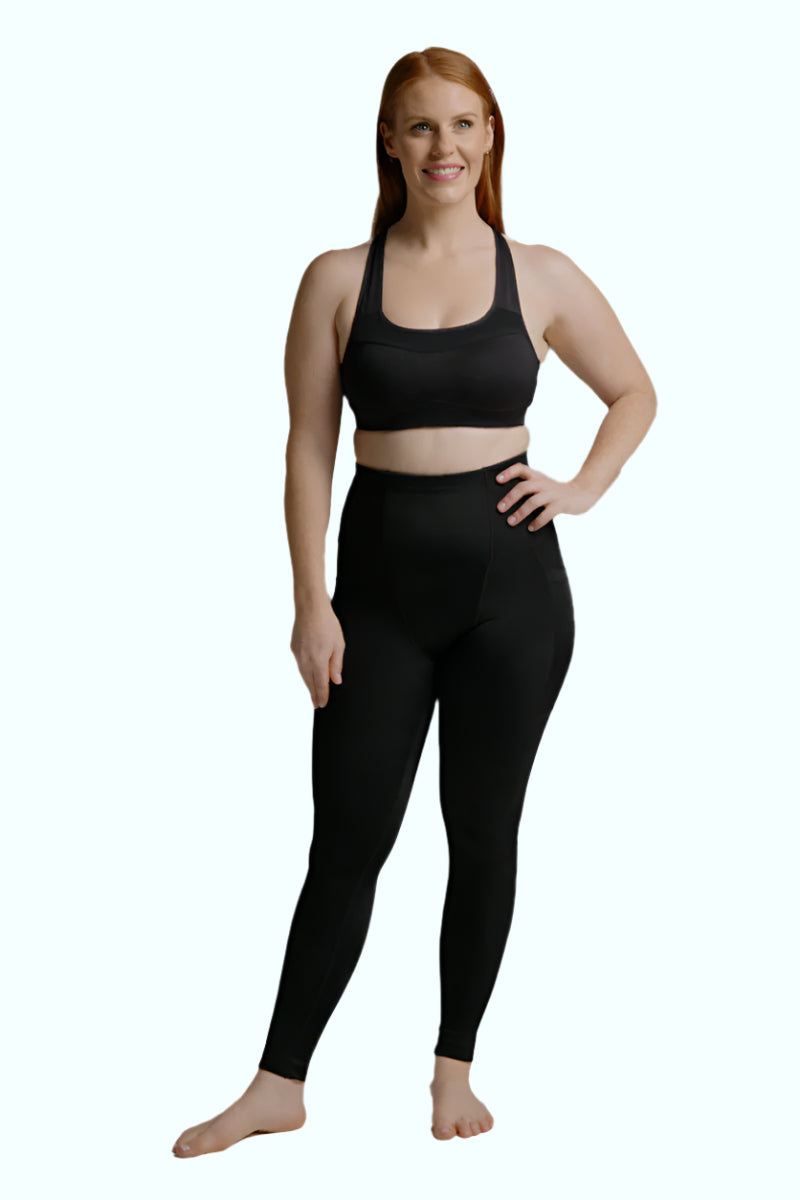Approximate Reading Time: 8 minutes
SUMMARY: A pregnancy belt and a belly band are popular generic names for a category of products that can help you cope with some of the challenges of pregnancy. However, they do have drawbacks that you should be aware of. While all belly belt/band products are safe when used according to manufacturer guidelines and/or your health care practitioner directions, the key to making the right decision for yourself, especially during the period of pregnancy, is knowledge and understanding, which we aim to provide in this blog.
We’ll explore the various options available in the market, and shed light on how compression garments, such as the SRC Pregnancy Leggings and Shorts, provide a beneficial alternative for many customers as well as why so many women’s pelvic health physiotherapists recommend them to their clients over a pregnancy belt or a belly band. While a belly band or a pregnancy belt can be useful for many women, it is important to consider individual preferences. If in any doubt, always consult with a healthcare professional.
Pregnancy is a transformative and beautiful journey, but it also comes with its fair share of discomforts
Approximately 70% of all pregnant women suffer low back pain and up to 45% exhibit symptoms of Pelvic Girdle Pain (PGP)1,2. Women with one or both conditions can find it difficult to cope with and participate in everyday activities.
What’s causing the Low Back Pain and Pelvic Girdle Pain?
One hormone released during pregnancy is Relaxin which softens ligaments and other soft tissues throughout the pregnancy and throughout breastfeeding. As the ligaments soften, the underlying joint becomes more mobile, potentially leading to pain of varying degrees of severity.
To alleviate the strain on the body and support the growing belly, many expectant mothers turn to a pregnancy belt or a belly band.
Pregnancy belt or belly band. What’s the difference?
A pregnancy belt is sometimes incorrectly referred to as a belly band and vice versa. With so many brands in the market competing for attention, it can be confusing as the original product naming becomes less relevant. However, for the sake of differentiation between these two appliances, we will use the traditional definitions:
A pregnancy belt is designed to carry your belly weight, offering support and relief to the lower back, hips, and abdominal muscles during pregnancy. Compared to a belly band, it is less lightweight and more rigid as it is meant to hold up the pregnant belly and take the pressure off your back. Pregnancy belts are typically worn over clothing and are usually narrower and more strap-like than belly bands, especially the part that lies across the front of the body. They are also referred to as belly belts, pregnancy braces, or straps.

Because the generic terms “belly band, belly belt, maternity belt, or maternity wrap” do not specify whether they are for pregnancy or post-natal use, these terms are ambiguous. As a rule of thumb:
- Terms like belly band and belly belt tend to be for use during pregnancy, which is the focus of this article.
- Terms like maternity belt, maternity wrap, and tummy wrap tend to be products designed for postpartum use.
A pregnancy belt / belly band is usually more helpful in the 2nd and 3rd trimesters, when your belly is bigger and heavier. In the 1st trimester, you may not need a maternity belt, unless you have a history of back problems or pelvic instability.
A pregnancy belt / belly band can be useful if you are physically active during pregnancy, such as walking, exercising, or working. It can help stabilise your pelvis, improve your balance, and prevent injuries. However, it can also make exercising harder depending on the type of exercise, as the pregnancy belt doesn’t “move with you”. If you are mostly sedentary, a maternity belt may not be necessary, and it may even discourage you from moving around. You should also avoid wearing a maternity belt for too long, as it may weaken your core muscles and reduce your blood circulation. For these reasons it may be worthwhile considering a pregnancy compression garment such as SRC Pregnancy Shorts or Leggings which doesn’t have the drawbacks associated with pregnancy belts allowing you to move more freely and not having the risk of weakening your muscles through muscle deactivation. They do however come at a higher price point than most pregnancy belly bands and belts.
A pregnancy belt is a matter of personal choice, and you should wear it only if you feel comfortable and benefit from it. Some women may find a maternity belt too tight, too hot, or too bulky. You should choose a belly band / pregnancy belt that fits you well, is made of breathable and flexible material, and has adjustable straps and hooks.
The Ugly – Why you need to take care when it comes to wearing a pregnancy belt or belly band
A belly band in the original definition of the product is no more than a stretchy bit of fabric to provide the coverage over your belly when your pants stop fitting you. So, it has no therapeutic purpose. This is further confused by some brands having the term “belly band” in their name yet providing a pregnancy belt that does have a therapeutic purpose! So going forward we will use the terms “pregnancy belt and belly band” interchangeably.

If used for too long a period of time or incorrectly, a pregnancy belt / belly band, falls into the same category as shapewear which by definition is designed to change the shape of your body with high levels of compression. [4,5]
Here are some medical opinions discussing the dangers of pregnancy belts or bands that may act like shapewear if worn incorrectly by their user:
According to Sherry A. Ross, MD, author of “she-ology, The Definitive Guide to Women’s Intimate Health. Period”, the benefits and risks for pregnant women depend on the maternity shapewear product, and how much you wear it. She goes on to say that:
"Shapewear worn during pregnancy that fits too tight or puts unwanted pressure on different areas of the body is never a good idea…. Besides creating a lot of discomfort, it can also cause pain in different parts of the body, reduced blood circulation, heartburn and yeast infections… No pregnancy or postpartum shapewear clothing should overly compress and squeeze internal organs including ribs, abdominal muscles, liver, spleen and intestines” [4]
Dr. Ross is most concerned about the Kardashian style waist trainers. “When the waist trainer is tied up too tightly, it could cause rib fractures, limit your mobility, affect your breathing capacity, restrict your abdominal muscles and affect your posture” [4]
“Shapewear that’s too tight may lead to health problems”, says neurologist Orly Avitzur, MD, medical advisor for Consumer Reports. "Any time we put on really tight garments we take the risk of compressing organs or nerves." Avitzur says that in her practice, she has had patients complain of tingling and numbness in the front to outer thigh region, from hip to knee. Avitzur has linked the cause back to restrictive clothing like shapewear or skinny jeans, in the article titled "How to Choose and Use Shapewear" on WebMD6.
You can also become overly dependent on the pregnancy belt which is the exact opposite of what you should be trying to achieve. “Activate don’t deactivate” is often heard advice of many women’s health physiotherapists as well as the founder of SRC Health, Sinead O’Donovan who developed a range of gentle medical grade compression garments; for different stages of a woman's life.
The commonly accepted advice about belly belts and bands means that you shouldn’t be wearing it all day long every day. Wearing it just for 2 to 3 hours every day is best. A pregnancy belt or belly band that supports your stomach and bottom all day, will take the load away from muscles and ligaments and may end up weakening your lower body muscles causing muscle wastage.
London-based physiotherapist Sammy Margo, a spokeswoman for the Chartered Society of Physiotherapy, explains: "What I say to my patients is use it or lose it. What we find is that women who wear maternity shapewear when they have no physical need can weaken muscles in their bottoms, stomachs and lower backs. After the birth of their baby, they are more likely to be injured as they lift and care for their newborns' she warns." [7]
So please ask your health care provider on how to wear your pregnancy belt or belly band to avoid putting pressure on your uterus. and Only wear a pregnancy belt for a couple of hours a day, never wear a pregnancy belt continually. Alternatively, there's always a more comfortable / practical alternative, one where you don't have to worry about deactivating your muscles that is discussed straight after The Bad.
The Bad – Why wearing a Belly Belt, Maternity Belt or Pregnancy Belt may not be your optimal solution
The issue with a belly band / pregnancy belt, even those that have stretchable inserts, is that they:
- do not easily move with your body,
- they can feel restrictive and need constant readjustment which can be frustrating to some (and perfectly ok for others).
- pregnancy belts / bands are not the most comfortable or flattering things to wear, especially if you are wearing them under anything that is fitted as they will show through.
- many pregnancy belts and maternity belts have hooks, loops or Velcro to adjust the belt / belly band and keep it in the right position and at the right tension. However, this also means there is a chance of these catching and damaging your clothes.
Earlier studies indicated that pelvic support belts were associated with poor compliance due to ‘garment-related problems including skin irritation from the seams and fasteners.
We recommend you try one on and/or make sure you can get a refund if the product simply irritates you when you have to constantly readjust when sitting down or getting up.
The Good - Why you should wear a pregnancy belly band/belt:
Usually prescribed for extra postural support for severe symptoms of Pelvic Girdle Pain (PGP) and Pelvic Instability, here are several good reasons to wear a belly band/ pregnancy belt during your pregnancy:
- Relieving pain in joints, muscles and lower back
- Assisting with the sacroiliac joint pain and hip joint pain
- Decrease the discomfort and provide support to the pelvic area during various activities by stabilising the pelvis and relieving pressure from the lower back.
- Help improve your posture
Although research has found 83% of women with Pelvic Girdle Pain (PGP) or Lower Back Pain (LBP) LBP experience reduced posterior pelvic pain when wearing a pelvic support belt, with only 12% experiencing no relief, and 5% reporting they felt worse (Depledge et al., 2005) other factors need to be considered when prescribing a pregnancy belt / belly band, given the target population is pregnant women. These factors include:
- low levels of compliance3 in wearing pregnancy belts due to issues like comfort,
- need for frequent re-adjustment, skin irritation from the seams and fasteners.
- positioning of the belt,
- accuracy in sizing,
- required compression,
- location to stimulate stabilising muscles, and
- effects on core body temperature (a special consideration, as this needs to be carefully regulated during pregnancy) (Damen et al.,2002; Ho et al., 2009b).
The Benefits of SRC Pregnancy Compression Shorts and Leggings
For those seeking an alternative to a belly band/pregnancy belt, SRC pregnancy leggings and shorts have gained recognition for their enhanced support, muscle activation, versatility, and tailored fit.
With 15 years’ experience under our belt, figuratively speaking, we know a thing or two about the industry and how to assist mothers to deal with the most common conditions during pregnancy.
SRC Pregnancy Shorts and Leggings are ideal for providing pain relief during pregnancy and treating Low Back Pain, Pelvic Girdle Pain, Mild Varicose Veins, Sciatica and Vulvar Varicosities.
Designed by women for women in consultation with an obstetrician, the SRC Pregnancy shorts and leggings are endorsed by the Australian Physiotherapy Association and Australian College of Midwives.
A Quasi‐Experimental Study To Evaluate The Use Of Compression Garments To Manage Prenatal Pelvic And Low Back Pain by Szkwara J, Hing W, Pope R, Rathbone E, Bond University, Robina, Australia, November 2017 concluded that:
"SRC Pregnancy Shorts are effective, thermally safe and a non-pharmacological option for prevention and management of pain during pregnancy."
Hundreds of women's health care professionals around the world recommend SRC compression garments for pregnancy and postpartum recovery, like Anna Scammel, who is a Masters-trained Women's Health & Pelvic Floor Physiotherapist from The Whole Mother in Sydney, who helps optimise your physical health during pregnancy and recovery. Here’s a 90 second video explaining why she favours SRC Pregnancy Leggings and Shorts over a pregnancy belt or belly band.
Dr. Amy Norman is the founder of Dynamic Chiropractic specializing in pregnancy discomfort and treatment of children discusses why pregnancy compression garments are often a better solution than a pregnancy belt for the treatment of pelvic girdle pain during pregnancy.
Michelle Kenway a Physiotherapist, internationally renowned author and exercise instructor for women, whose educational videos have been viewed over 45 million times on YouTube. Here is an extensive video about pelvic pain and what you can do about it, together with a recommendation of the SRC Pregnancy Leggings that starts at 3min and 12 seconds.
SRC Pregnancy compression shorts and leggings are more expensive but also provide worthwhile benefits:
- Enhanced Support: SRC Pregnancy leggings and shorts offer targeted and consistent compression to the pelvic area, lower back, and hips. They are a purpose made medical grade compression garment (leggings graduated 4mmHg to 15mmHG). This can help reduce pain and discomfort associated with pregnancy. With a gusset panel that provides compression to the perineum, the SRC pregnancy garments also assist with vulvar varicosities - a condition a pregnancy belt/belly band cannot address unless through the use of a different pelvic belt attachment that provides compression to the pubic area but resembles a marriage of a mediaeval chastity device and a jockstrap! Not exactly comfortable or a sexy fashion statement.
- Muscle Activation: SRC Pregnancy compression garments are designed to activate specific muscles, providing additional support and stability during movements. This can aid in maintaining good posture and reducing strain. They can be worn 24 hours a day without deactivating your muscles which as discussed above presents a challenge with a pregnancy belt or belly band.
- Versatility: SRC Pregnancy leggings and shorts can be worn throughout the day, providing continuous support, and promoting blood circulation, assisting you in getting through the demands of work and exercise and aid in reduction of leg swelling. They can be worn from 12 weeks, until term and keep you looking and feeling fabulous. They are suitable for various activities, including exercise, without compromising comfort. They can be worn as outerwear or as an undergarment and you can sleep in them to get the necessary support through the night!
- Tailored Fit: SRC Pregnancy compression garments are available in a range of sizes and accommodate the changing shape of your body during pregnancy growing with your bump! The expandable or adjustable (depending on the model you choose) waistband ensures a comfortable and personalised fit.
And here are just some of the things our customers have to say about our pregnancy garments: (you can read hundreds of reviews from verified buyers on our website)
"Have found the src pregnancy shorts to be very helpful for my pelvic girdle pain. Now not worried about going for walks."
"Absolute game changer! I wish I got the shorts sooner, and currently in my 3rd pregnancy & chasing two toddlers too! These shorts have provided wonderful support for me to continue enjoying my pregnancy as I go into the third trimester!"
"Amazing. Definitely helps with back strain and the pain from symphysis pubis dysfunction and pelvic girdle"
"Great product. Started wearing the mini over the bump shorts at 22 weeks and felt near instant relief from SIJ pain and an aching lower back."
"Great compression. Definitely pays to measure up correctly, as having the correct size can create the compression that you need otherwise they don’t serve their purpose. Have lived in these since they arrived!!"
"Worth the money. Gave SO much relief for vulvar varicose veins. A total game changer in a good way!"
"Comfort & Confidence. I lived and loved my SRC Pregnancy full length over the belly tights. I felt secure, comfortable and confident making my belly shaped perfectly and dressing to a growing belly easy."

Some women combine a pregnancy belly band/belt and their SRC Pregnancy Compression Shorts /Leggings. The benefit for women with severe pain is that they can wear their SRC Shorts/Leggings 24 hours a day without causing atrophy due to prolonged muscle deactivation and during periods where they need to be on their feet a lot, they can combine both products by adding the pregnancy belt for additional support.
The major differences between SRC pregnancy garment and a pregnancy belt/band can be summarised as follows:
Pregnancy belly band/belt:
- Is not recommended to be worn day and night due to the risk of muscle deactivation. To get the right level of compression you are relying on your ‘feel’ and risking the belt providing a potential level of compression that is too high.
- Can’t treat multiple conditions like the SRC pregnancy garments that utilise Anatomical Support Panels to help with Lower Back Pain, Vulvar Varicosities, Pelvic Instability and Pelvic Girdle Pain.
- Does not have True Cross Compression - multi-layered support panels that provide consistent and anatomically targeted compression during movement which means constant readjustment of your belly band/belt, for example from sitting to standing.
- Does not usually have moisture wicking fabric that eliminates odour.
- Does not have flat lock seams that increase comfort and don’t aggravate wounds.
- Relies on adjustable Velcro zips and clips making it less comfortable and convenient which in turn lowers what the healthcare industry calls the "compliance rate" with many women simply not wearing the belly band/belt at all.
- Are not a multi-purpose garment that is ideal for exercise, work and everyday wear as well as for aesthetic reasons under fitted clothing.
In short, the SRC compression leggings and shorts have all the benefits of a belly band or pregnancy belt with no disadvantages listed above and we have the science to prove it.

A holistic approach to management of these pregnancy conditions will produce the best outcome. Visiting a Women’s Health Physiotherapist can greatly assist as they will provide you with a tailored program which may include clinical Pilates as well as fit you for the right garment for supporting you through your pregnancy journey.


